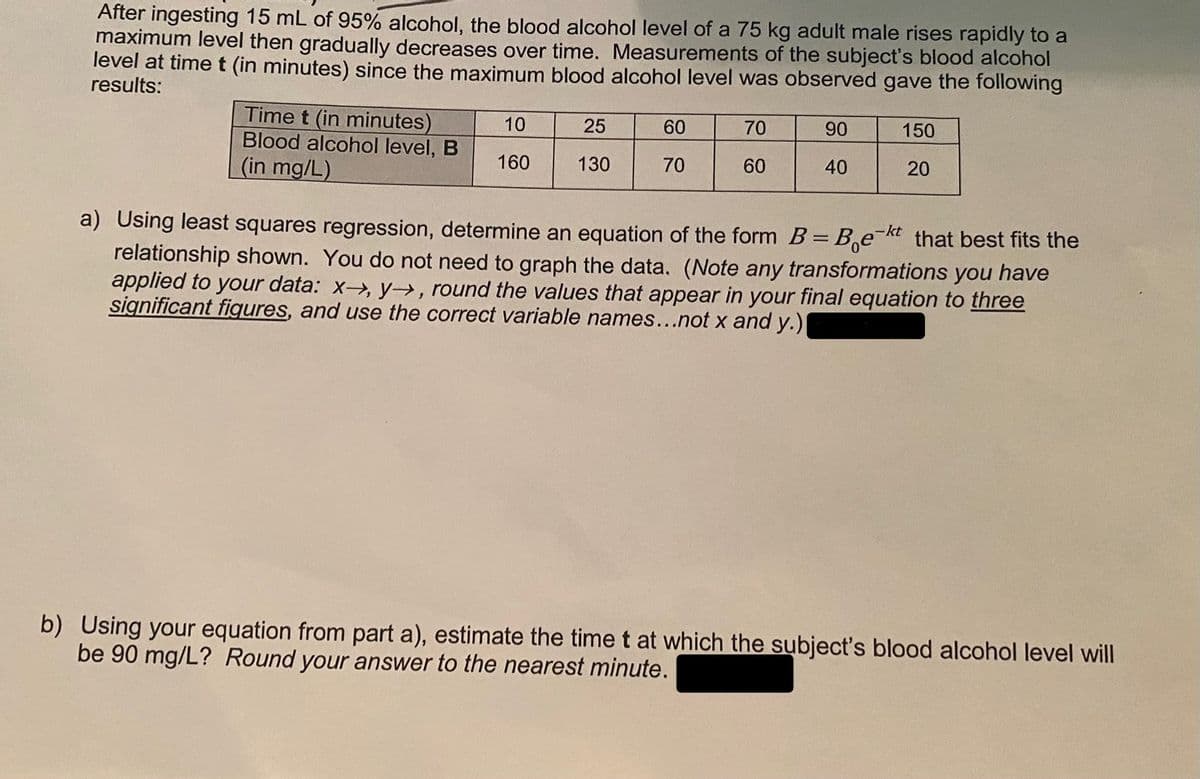After ingesting 15 mL of 95% alcohol, the blood alcohol level of a 75 kg adult male rises rapidly to a maximum level then gradually decreases over time. Measurements of the subject's blood alcohol level at time t (in minutes) since the maximum blood alcohol level was observed gave the following results: Time t (in minutes) Blood alcohol level, B (in mg/L) 10 25 60 70 90 150 160 130 70 60 40 20 ) Using least squares regression, determine an equation of the form B=B,ekt that best fits the relationship shown. You do not need to graph the data. (Note any transformations you have applied to your data: x, y→, round the values that appear in your final equation to three significant figuro
After ingesting 15 mL of 95% alcohol, the blood alcohol level of a 75 kg adult male rises rapidly to a maximum level then gradually decreases over time. Measurements of the subject's blood alcohol level at time t (in minutes) since the maximum blood alcohol level was observed gave the following results: Time t (in minutes) Blood alcohol level, B (in mg/L) 10 25 60 70 90 150 160 130 70 60 40 20 ) Using least squares regression, determine an equation of the form B=B,ekt that best fits the relationship shown. You do not need to graph the data. (Note any transformations you have applied to your data: x, y→, round the values that appear in your final equation to three significant figuro
Chapter6: Exponential And Logarithmic Functions
Section6.8: Fitting Exponential Models To Data
Problem 3TI: Table 6 shows the population, in thousands, of harbor seals in the Wadden Sea over the years 1997 to...
Related questions
Question
100%

Transcribed Image Text:After ingesting 15 mL of 95% alcohol, the blood alcohol level of a 75 kg adult male rises rapidly to a
maximum level then gradually decreases over time. Measurements of the subject's blood alcohol
level at time t (in minutes) since the maximum blood alcohol level was observed gave the following
results:
Time t (in minutes)
Blood alcohol level, B
(in mg/L)
10
25
60
70
90
150
160
130
70
60
40
20
a) Using least squares regression, determine an equation of the form B= Be-kt that best fits the
relationship shown. You do not need to graph the data. (Note any transformations you have
applied to your data: x→, y→, round the values that appear in your final equation to three
significant figures, and use the correct variable names...not x and y.)|
b) Using your equation from part a), estimate the time t at which the subject's blood alcohol level will
be 90 mg/L? Round your answer to the nearest minute.
Expert Solution
This question has been solved!
Explore an expertly crafted, step-by-step solution for a thorough understanding of key concepts.
Step by step
Solved in 2 steps with 1 images

Recommended textbooks for you


Algebra & Trigonometry with Analytic Geometry
Algebra
ISBN:
9781133382119
Author:
Swokowski
Publisher:
Cengage


Algebra & Trigonometry with Analytic Geometry
Algebra
ISBN:
9781133382119
Author:
Swokowski
Publisher:
Cengage